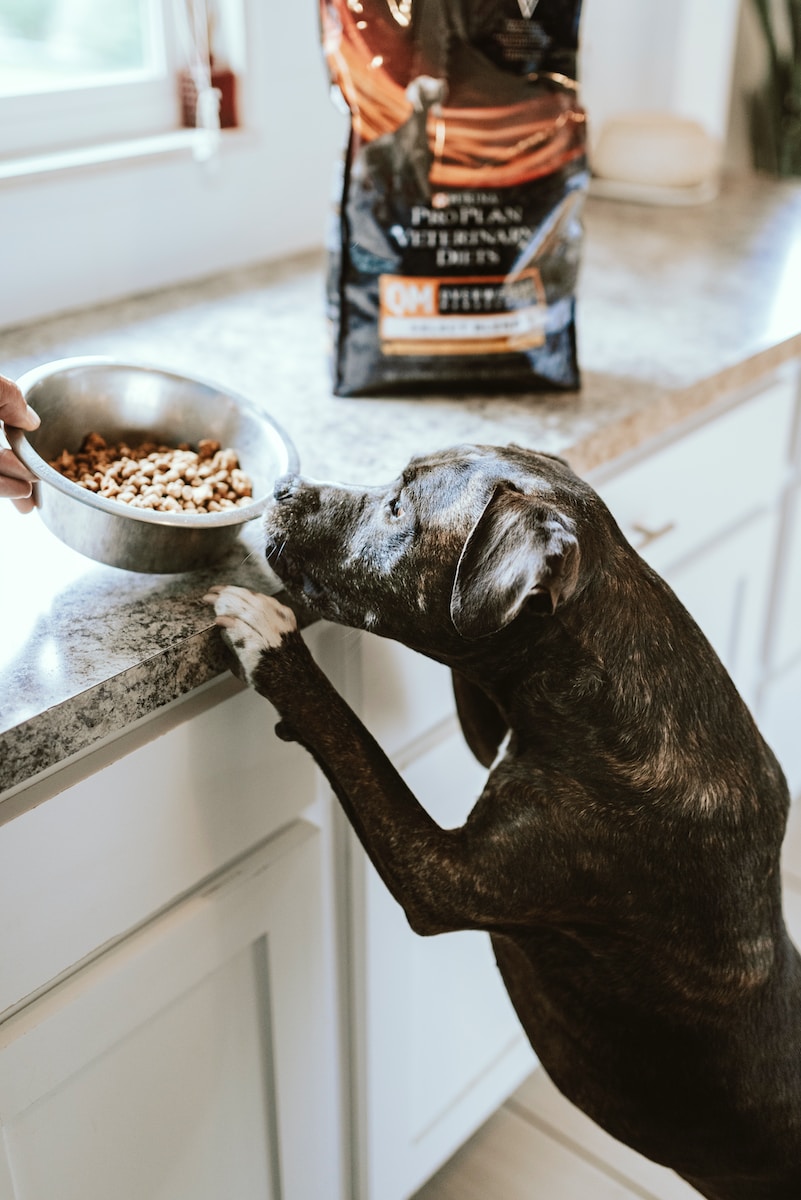Choosing the right dog food can be a daunting task, especially with so many options available on the market. As a dog owner, you want to ensure that your furry friend is getting the proper nutrition they need to live a healthy and happy life. But with so many different brands, ingredients, and formulas to choose from, how do you know which one is right for your dog?
Well, the first step is to understand your dog’s unique nutritional needs. Just like humans, dogs have specific dietary requirements based on their age, size, breed, and activity level. For example, a small breed dog may require a different type of food than a large breed dog, and a senior dog may need a different formula than a puppy. By understanding your dog’s nutritional needs, you can narrow down your options and choose a food that will provide them with the right balance of nutrients.
In this article, we’ll walk you through the process of choosing the proper dog food for your furry friend. We’ll cover everything from understanding dog food labels to selecting the right type of food for your dog’s specific needs. By the end of this article, you’ll have all the information you need to make an informed decision and choose a food that will keep your dog healthy and happy for years to come.
Understanding Your Dog’s Nutritional Needs
As a dog owner, it’s important to understand your furry friend’s nutritional needs. A balanced diet is critical to your dog’s overall health and wellbeing. In this section, we’ll discuss the different life stages of dogs and their nutritional requirements.
Life Stages
Dogs go through different life stages, and their nutritional needs vary depending on their age. A puppy, for example, needs a different diet than an adult dog. Here’s a breakdown of the different life stages of dogs:
- Puppy: Puppies require a diet that is high in protein, fat, and calories to support their rapid growth and development. They also need a diet that is rich in calcium and phosphorus to support their bone growth.
- Adult: Adult dogs need a balanced diet that includes protein, carbohydrates, fats, vitamins, and minerals. The amount of food they need depends on their size, breed, and activity level.
- Senior: Senior dogs need a diet that is lower in calories and fat to prevent obesity. They also need a diet that is high in fiber to promote good digestion.
Nutritional Requirements
Dogs require six essential nutrients to maintain good health: water, protein, fat, carbohydrates, vitamins, and minerals. Here’s a breakdown of each nutrient and its importance:
- Water: Water is essential for all living creatures, and dogs are no exception. Dogs need access to clean water at all times to stay hydrated.
- Protein: Protein is essential for building and repairing tissues, and it’s critical for muscle development. Dogs require high-quality protein sources, such as meat, fish, and eggs, in their diet.
- Fat: Fat provides energy and helps dogs absorb vitamins. It’s also important for healthy skin and coat. Dogs require a moderate amount of fat in their diet.
- Carbohydrates: Carbohydrates provide energy and fiber. Dogs can digest and utilize carbohydrates, but they don’t require a large amount in their diet.
- Vitamins: Vitamins are essential for many bodily functions, including immune system function, vision, and bone growth. Dogs require a balanced mix of vitamins in their diet.
- Minerals: Minerals are essential for healthy bones, teeth, and muscle function. Dogs require a balanced mix of minerals in their diet.
In conclusion, understanding your dog’s nutritional needs is critical to their overall health and wellbeing. By providing a balanced diet that meets their nutritional requirements, you can help ensure a long and healthy life for your furry friend.
Reading Dog Food Labels
As a responsible dog owner, you want to ensure that your furry friend is getting the best possible nutrition. One of the first things you need to do is to learn how to read dog food labels. This will help you make an informed decision when choosing the right food for your dog. In this section, we will discuss the three main components of dog food labels: the AAFCO statement, the guaranteed analysis, and the ingredient list.
AAFCO Statement
The AAFCO (Association of American Feed Control Officials) statement is a crucial part of the dog food label. It tells you whether the food meets the minimum nutritional requirements established by the AAFCO. Look for a statement that says something like “This dog food is formulated to meet the nutritional levels established by the AAFCO Dog Food Nutrient Profiles for all life stages.”
It’s important to note that the AAFCO statement doesn’t guarantee that the food is of high quality or that it’s the best choice for your dog. It only means that the food meets the minimum nutritional requirements established by the AAFCO.
Guaranteed Analysis
The guaranteed analysis section of the dog food label provides information on the minimum and maximum levels of crude protein, crude fat, crude fiber, and moisture in the food. This information can help you determine whether the food is appropriate for your dog’s age, breed, and activity level.
When reading the guaranteed analysis, keep in mind that the percentages listed are on an “as fed” basis. This means that the percentages include the moisture content of the food. If you want to compare the nutrient levels of different dog foods, you need to look at the dry matter basis. To convert the percentages to a dry matter basis, you need to subtract the moisture percentage from 100 and then multiply each nutrient percentage by 100 divided by the result.
Ingredient List
The ingredient list is another essential component of the dog food label. It tells you what ingredients are in the food and in what order they appear. Ingredients are listed in descending order by weight. This means that the first ingredient listed is the most abundant, and the last ingredient listed is the least abundant.
When reading the ingredient list, look for whole food ingredients like meat, fish, fruits, and vegetables. Avoid foods that contain by-products, fillers, and artificial preservatives. Keep in mind that ingredients like “meat meal” or “animal by-products” can come from a variety of sources and may not be of high quality.
In conclusion, learning how to read dog food labels is an essential skill for any dog owner. By understanding the AAFCO statement, the guaranteed analysis, and the ingredient list, you can make an informed decision when choosing the right food for your furry friend.
Choosing The Right Type of Dog Food
When it comes to choosing the right type of food for your dog, there are a few options to consider. The two most common types of dog food are dry kibble and wet food. Let’s take a closer look at each of these options.
Dry Kibble
Dry kibble is the most popular type of dog food and is often the most convenient option for pet owners. It is easy to store, has a long shelf life, and is generally less expensive than wet food. Dry kibble also helps to keep your dog’s teeth clean and healthy by scraping away plaque and tartar as they chew.
When selecting a dry kibble for your dog, there are a few things to keep in mind. Look for a high-quality kibble that contains a good balance of protein, fat, and carbohydrates. You should also choose a kibble that is appropriate for your dog’s age, breed, and activity level.
Wet Food
Wet food, also known as canned food, is another option to consider when choosing the right type of food for your dog. Wet food is often more palatable than dry kibble, making it a good option for picky eaters or dogs with dental issues. It also contains more moisture than dry kibble, which can help keep your dog hydrated.
When selecting a wet food for your dog, look for a high-quality option that contains a good balance of protein, fat, and carbohydrates. You should also choose a wet food that is appropriate for your dog’s age, breed, and activity level. Keep in mind that wet food can be more expensive than dry kibble and has a shorter shelf life once opened.
When it comes to choosing the right type of food for your dog, there is no one-size-fits-all solution. Both dry kibble and wet food have their pros and cons, and the best option for your dog will depend on their individual needs and preferences. By considering factors such as your dog’s age, breed, and activity level, you can make an informed decision and choose a high-quality food that will keep your furry friend healthy and happy.
Important Nutrients for Your Dog
As a dog owner, you want to ensure that your furry friend is getting all the necessary nutrients to maintain a healthy and happy life. Here are the most important nutrients your dog needs:
Protein
Protein is essential for your dog’s growth, maintenance, and repair of tissues. It also helps with the production of hormones, enzymes, and antibodies. Dogs require a higher amount of protein than humans, and it should make up at least 18% of their diet. Good sources of protein for dogs include meat, fish, eggs, and dairy products.
Fat
Fat is an important source of energy for your dog, and it also helps with the absorption of vitamins and minerals. It should make up at least 5% of their diet. However, it’s important to note that not all fats are created equal. Your dog needs healthy fats, such as omega-3 and omega-6 fatty acids, which can be found in fish, flaxseed, and chicken.
Carbohydrates
Carbohydrates provide your dog with energy and help keep their digestive system healthy. They should make up around 30% of their diet. Good sources of carbohydrates for dogs include whole grains, vegetables, and fruits.
Fiber
Fiber is important for your dog’s digestive health and can help prevent constipation. It can also help regulate blood sugar levels and lower cholesterol. Good sources of fiber for dogs include vegetables, fruits, and whole grains.
It’s important to note that every dog is different, and their nutritional needs may vary depending on their age, size, and activity level. Consult with your veterinarian to determine the best diet for your dog. Also, be sure to read the labels on dog food carefully to ensure that it contains all the necessary nutrients your dog needs.
Avoiding Common Dog Food Myths and Misinformation
As a dog owner, it’s important to know how to choose the right food for your furry friend. However, there is a lot of misinformation and myths out there that can make it difficult to make an informed decision. Here are some common dog food myths and the truth behind them.
Grain-Free Dog Food
One of the most popular dog food myths is that grain-free dog food is better for your pet. However, this is not necessarily true. While some dogs may have allergies or sensitivities to grains, most dogs can digest them without any problems. In fact, many grain-free dog foods are actually higher in fat and calories, which can lead to weight gain and other health problems.
Animal Byproducts
Another common myth about dog food is that animal byproducts are bad for your pet. However, this is not necessarily true either. Animal byproducts can actually be a good source of protein for your dog. Byproducts are the parts of an animal that are not typically used for human consumption, such as organs and bones. These parts are often rich in nutrients that your dog needs to stay healthy.
Fillers
Many people believe that fillers in dog food are bad for your pet. However, this is not necessarily true either. Fillers are ingredients that are added to dog food to help with texture, consistency, and nutritional balance. Some common fillers include rice, corn, and wheat. While these ingredients may not be as nutritious as other ingredients, they can still provide your dog with important nutrients and energy.
When choosing a dog food, it’s important to look at the ingredients and nutritional information. Don’t be swayed by popular myths and misinformation. Instead, focus on finding a high-quality dog food that meets your pet’s specific needs. By doing so, you can help ensure that your furry friend stays healthy and happy for years to come.
Special Dietary Needs
As a dog owner, you may encounter situations where your furry friend has special dietary needs. This may be due to allergies, weight management, age, or breed. It is important to understand these needs to ensure that your dog is healthy and happy. In this section, we will discuss some of the common special dietary needs and how to choose the right dog food for your pup.
Allergies
Just like humans, dogs can have food allergies. Common allergens include beef, chicken, dairy, and grains. If your dog has an allergy, it is important to find a food that does not contain the allergen. Look for dog food that is labeled as hypoallergenic or limited ingredient. These foods typically contain a single protein source and a single carbohydrate source. You can also talk to your vet about prescription dog food for allergies.
Weight Management
If your dog is overweight, it is important to choose a dog food that is lower in calories. Look for dog food that is labeled as weight management or low calorie. These foods typically have fewer calories and more fiber to help your dog feel full. You can also talk to your vet about a weight loss plan for your dog, which may include a combination of diet and exercise.
Senior Dogs
As dogs age, their nutritional needs change. Senior dogs may require fewer calories and more protein to maintain muscle mass. Look for dog food that is labeled as senior or mature. These foods typically have fewer calories and more protein than regular dog food. You can also talk to your vet about supplements for joint health and mobility.
Puppies
Puppies have different nutritional needs than adult dogs. They require more protein and fat to support their growth and development. Look for dog food that is labeled as puppy food or for all life stages. These foods are formulated to meet the nutritional needs of growing puppies. You can also talk to your vet about feeding schedules and portion sizes for your puppy.
Large Breed Dogs
Large breed dogs have different nutritional needs than small breed dogs. They require more protein and fewer calories to maintain a healthy weight. Look for dog food that is labeled as large breed. These foods typically have a lower calorie content and added supplements for joint health. You can also talk to your vet about portion sizes and feeding schedules for your large breed dog.
Small Breed Dogs
Small breed dogs have smaller stomachs and require more frequent meals. They also have higher energy needs than larger dogs. Look for dog food that is labeled as small breed. These foods are formulated to meet the nutritional needs of small breed dogs. They typically have a higher calorie content and smaller kibble size. You can also talk to your vet about feeding schedules and portion sizes for your small breed dog.
In conclusion, understanding your dog’s special dietary needs is important for their health and well-being. By choosing the right dog food, you can ensure that your furry friend is getting the nutrients they need to thrive. Don’t hesitate to talk to your vet if you have any questions or concerns about your dog’s diet.
How to Choose The Best Dog Food Brand
When it comes to choosing the best dog food brand, there are a few things to keep in mind. You want to make sure that your dog is getting the proper nutrition they need to stay healthy and happy. Here are some tips on how to choose the best dog food brand:
Research
The first step in choosing the best dog food brand is to do your research. Look for brands that have a good reputation and are well-known in the industry. You can also check online reviews and ratings to see what other dog owners have to say about the brand. Make sure to read the ingredients list and nutritional information to ensure that the brand meets your dog’s dietary needs.
High-Quality Ingredients
The ingredients in your dog’s food are important for their overall health and well-being. Look for brands that use high-quality ingredients, such as real meat, vegetables, and whole grains. Avoid brands that use fillers, artificial preservatives, and by-products. It’s important to choose a brand that uses ingredients that are appropriate for your dog’s age, breed, and activity level.
Veterinary Nutritionist
Consulting with a veterinary nutritionist can help you choose the best dog food brand for your furry friend. A veterinary nutritionist can provide you with personalized recommendations based on your dog’s specific needs and dietary requirements. They can also help you navigate the confusing world of dog food and provide you with information on how to read labels and choose the best ingredients.
In conclusion, choosing the best dog food brand requires some research and consideration. Look for brands that use high-quality ingredients and have a good reputation in the industry. Consulting with a veterinary nutritionist can also help you make an informed decision and ensure that your dog is getting the proper nutrition they need. Remember to always read the label and choose a brand that is appropriate for your dog’s age, breed, and activity level.
Choosing the proper dog food is key to your dog’s happines
Choosing the proper dog food for your furry friend can be a daunting task, but it is essential to ensure their health and well-being. As a dog owner, you want to provide your pet with the best possible nutrition to maintain their health and energy levels.
When selecting dog food, it is important to consider your dog’s age, breed, weight, and activity level. You should also take into account any health issues or dietary restrictions your dog may have. Consult with your veterinarian to ensure that you are selecting the best food for your dog’s specific needs.
Remember to always read the label and ingredient list carefully. Look for high-quality protein sources, such as chicken, beef, or fish, as well as whole grains and vegetables. Avoid foods with fillers, by-products, and artificial preservatives.
Consider the type of dog food that best suits your lifestyle and budget. Dry kibble is the most common and affordable option, while wet food can provide additional moisture and flavor. Raw and homemade diets can also be an option, but it is important to ensure that they are nutritionally balanced and safe for your dog.
Finally, remember to introduce new dog food gradually to avoid digestive upset. Start by mixing a small amount of the new food with your dog’s current food and gradually increase the amount over several days.
By following these guidelines and consulting with your veterinarian, you can select the best possible dog food for your furry friend and ensure their health and happiness for years to come.
Related Resources
https://en.wikipedia.org/wiki/Dog_food
Whats the best dog food






